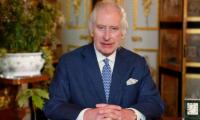The Sanat Initiative is holding an art exhibition titled ‘Ambivalence’ until May 8. The artist, Waseem Ahmed, says this body of work is about the current global environmental issues.
“While alerting about the fragility of our vital resources, the paintings in ‘Ambivalence’ suggest a feeling of threat and violence, and at the same time give awareness to save the environment for our next generation.”
The catalogue accompanying this exhibition says Ahmed was born in Hyderabad in 1976. He graduated with honours in miniature painting from the National College of Arts in Lahore in 2000. He currently lives and works in Lahore.
Ahmed hails from the generation of artists who initiated the “contemporary miniature movement” in Pakistan about two decades ago. In Pakistan, the traditional miniature art has been a starting point for many contemporary artists, who have honoured the technique as cultural heritage while reinterpreting and reinventing it in their own way.
Ahmed has distinguished his work by producing creatively incisive images with innovative stylistic and iconographic contributions within a practice that is rigorously traditional, placing him among the most acclaimed contemporary artists of his time.
Working in a variety of sizes, he combines drawing, gouache, pigments, gold and silver leaf on wasli paper, his substrate of choice. At the heart of his imagery lie the human figure and the boundaries that divide humanity in relation to his own historical and social context, and in close connection with the conflict and displacement that tinge our current time.
His rich vocabulary of images often refers to mythology or history, both Eastern and Western. His work bridges our cultural heritage and the turbulence of our time.
He has displayed extensively nationally and internationally since 2001. His works have been showcased in Pakistan, the USA, Switzerland, Germany, the UK, Belgium, Greece, the UAE, India, Bangladesh, Nepal, Japan, Australia, Turkey, Lebanon and France.
He has been a part of numerous national and international workshops and residency programmes. He has participated in the Karachi Biennale 2019, the Kathmandu Triennale 2017 and has to his credit a museum show ‘Dahlem Karkhana’, which was curated by Martina Stoye at the Museum of Asian Art in Berlin.
Ahmed is also the Nominator for the Sovereign Asian Art Prize, Hong Kong since 2017. Since 2008, his works continue to auction at major auction houses, and his works feature in the permanent collection of Museum of Asian Art, the Berlin State Museums and the British Museum.
Quoting architect, photographer and researcher Maria Waseem, the catalogue says Ahmed’s latest works represent a state of uncertainty, a reflection on the unpredictability that is all pervasive and has changed life for everyone so abruptly, with only a vague sense of what the future holds, and the question — have we learnt anything from the past?
“There has always been a constant battle between humans and nature, as humans are the only species that try to control and mould nature to their own advantage. Every now and then nature strikes back and seizes control. When this happens, nature sets a new course for life to evolve, as we are witnessing in these times of the pandemic.”
She says Ahmed in this body of work has given an insight into how he sees the present while keeping the past in mind. He studies historical imagery intensely and relates them to the present times as he sees history in its cyclical form, repeating itself again and again, she adds.
“It is Waseem’s belief that artists are the visual representators of human emotions. They act as a mirror to show what a society is going through or what it looks like at any given point of time. In his new collection, Waseem has highlighted the feeling of hope and, at the same time, disappointment.”
She says he reflects on how the global lockdown has affected everyone, including himself, mentally and emotionally, and explores all shades of emotional experiences — how love and hate have started to coincide with hope and disappointment, how darkness has started to engulf light as hope started to diminish, and how suddenly the acts of love and kindness became weapons to kill.
“A human, being a social animal, has been forced to become asocial in order to save humanity. We are all connected to nature, and when we try to control and exploit nature to cater to the insatiable needs of the human society, we forget that when nature strikes back with catastrophic consequences, we, the humans, have to start from scratch and relearn all over again.”
She says Ahmed his new works has used imagery of evil versus good and how these get blurred over time. We all have good and bad as part of our personality, and we maintain an equilibrium between the two to keep society on even keel, she adds.
“But with prosperity and technological advantages, this balance gets skewed, until some global incident happens, like world wars or pandemics or even a scientific revolution, and this completely obliterates the well-established signposts that propel human society forward, and then we have to relearn or redesign the moral compass to re-establish the equilibrium.”
She says that according to Ahmed, how one appears and what is inside can be completely different. “Our state is similar during the pandemic. The contradictions which this change has brought in our usual lifestyle has revealed the hidden or repressed sides which we had learnt over a long period of time to repress in order to maintain the balance.”
Hence, she points out, a different kind of approach to things has started to evolve with a lot of contradictions within us in the process.
She says Ahmed believes that life is like an aquarium these days, where we build a glass box and decorate it with beautiful plants making a comfortable and beautiful environment for the fish, but in reality, the glass is transparent and constraining, as we have restrained the movement of fish, which was once moving freely in the open seas and rivers.
She remarks that Ahmed has shown a reflection of his changing inner self in his work: how his perception of life and its morals are changing and how he is seeing the roles reversing. “Now he leaves it to the audience to interpret these in the light of their own experiences, since each of us has been affected differently by this new state of ‘Ambivalence’.”
— Pictures courtesy Sanat Initiative
Commuters make their way through a partially deserted bridge in Karachi. — AFP/Filefor Outcome / of OutcomeThe Sanat...
This representational image shows an advertisement stall of BankIslami. — Facebook@BankIslami Pakistan...
Department of Visual Studies of the University of Karachi seen in this image. — karachiartdirectory.com/FileThe...
The entrance of the University of Karachi. — APP/FileThe University of Karachi extended the submission of PhD...
A visitor is keenly interested in books at a stall during the 19th Karachi International Book Fair at the Expo...
This representational image shows a person holding a gavel. — Pexels/FileA banking court has handed down a...







